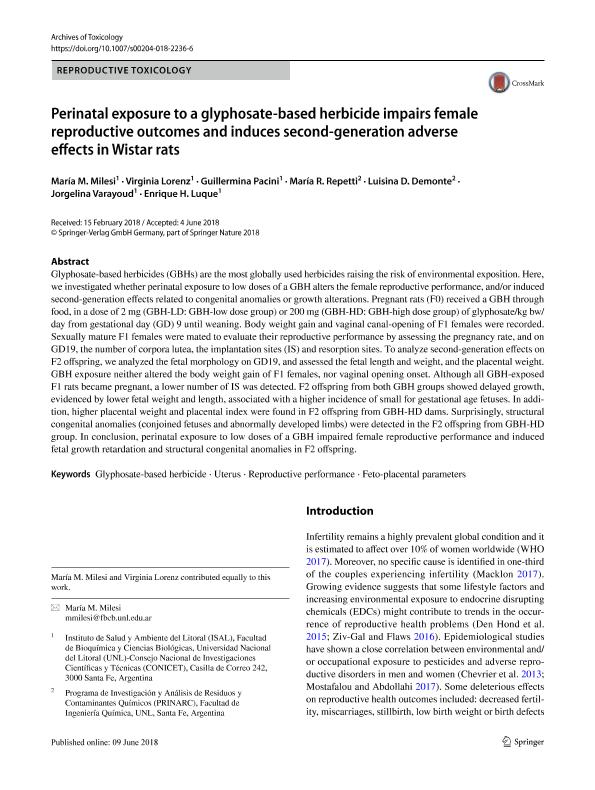Mostrar el registro sencillo del ítem
dc.contributor.author
Milesi, Maria Mercedes

dc.contributor.author
Lorenz, Virginia

dc.contributor.author
Pacini, Guillermina

dc.contributor.author
Repetti, María Rosa

dc.contributor.author
Demonte, Luisina Delma

dc.contributor.author
Varayoud, Jorgelina Guadalupe

dc.contributor.author
Luque, Enrique Hugo

dc.date.available
2019-09-27T19:18:32Z
dc.date.issued
2018-08
dc.identifier.citation
Milesi, Maria Mercedes; Lorenz, Virginia; Pacini, Guillermina; Repetti, María Rosa; Demonte, Luisina Delma; et al.; Perinatal exposure to a glyphosate-based herbicide impairs female reproductive outcomes and induces second-generation adverse effects in Wistar rats; Springer; Archives of Toxicology; 92; 8; 8-2018; 2629-2643
dc.identifier.issn
0340-5761
dc.identifier.uri
http://hdl.handle.net/11336/84712
dc.description.abstract
Glyphosate-based herbicides (GBHs) are the most globally used herbicides raising the risk of environmental exposition. Here, we investigated whether perinatal exposure to low doses of a GBH alters the female reproductive performance, and/or induced second-generation effects related to congenital anomalies or growth alterations. Pregnant rats (F0) received a GBH through food, in a dose of 2 mg (GBH-LD: GBH-low dose group) or 200 mg (GBH-HD: GBH-high dose group) of glyphosate/kg bw/day from gestational day (GD) 9 until weaning. Body weight gain and vaginal canal-opening of F1 females were recorded. Sexually mature F1 females were mated to evaluate their reproductive performance by assessing the pregnancy rate, and on GD19, the number of corpora lutea, the implantation sites (IS) and resorption sites. To analyze second-generation effects on F2 offspring, we analyzed the fetal morphology on GD19, and assessed the fetal length and weight, and the placental weight. GBH exposure neither altered the body weight gain of F1 females, nor vaginal opening onset. Although all GBH-exposed F1 rats became pregnant, a lower number of IS was detected. F2 offspring from both GBH groups showed delayed growth, evidenced by lower fetal weight and length, associated with a higher incidence of small for gestational age fetuses. In addition, higher placental weight and placental index were found in F2 offspring from GBH-HD dams. Surprisingly, structural congenital anomalies (conjoined fetuses and abnormally developed limbs) were detected in the F2 offspring from GBH-HD group. In conclusion, perinatal exposure to low doses of a GBH impaired female reproductive performance and induced fetal growth retardation and structural congenital anomalies in F2 offspring.
dc.format
application/pdf
dc.language.iso
eng
dc.publisher
Springer

dc.rights
info:eu-repo/semantics/openAccess
dc.rights.uri
https://creativecommons.org/licenses/by-nc-sa/2.5/ar/
dc.subject
FETO-PLACENTAL PARAMETERS
dc.subject
GLYPHOSATE-BASED HERBICIDE
dc.subject
REPRODUCTIVE PERFORMANCE
dc.subject
UTERUS
dc.subject.classification
Salud Pública y Medioambiental

dc.subject.classification
Ciencias de la Salud

dc.subject.classification
CIENCIAS MÉDICAS Y DE LA SALUD

dc.title
Perinatal exposure to a glyphosate-based herbicide impairs female reproductive outcomes and induces second-generation adverse effects in Wistar rats
dc.type
info:eu-repo/semantics/article
dc.type
info:ar-repo/semantics/artículo
dc.type
info:eu-repo/semantics/publishedVersion
dc.date.updated
2019-09-27T14:56:56Z
dc.journal.volume
92
dc.journal.number
8
dc.journal.pagination
2629-2643
dc.journal.pais
Alemania

dc.journal.ciudad
Berlin
dc.description.fil
Fil: Milesi, Maria Mercedes. Consejo Nacional de Investigaciones Científicas y Técnicas. Centro Científico Tecnológico Conicet - Santa Fe. Instituto de Salud y Ambiente del Litoral. Universidad Nacional del Litoral. Instituto de Salud y Ambiente del Litoral; Argentina
dc.description.fil
Fil: Lorenz, Virginia. Consejo Nacional de Investigaciones Científicas y Técnicas. Centro Científico Tecnológico Conicet - Santa Fe. Instituto de Salud y Ambiente del Litoral. Universidad Nacional del Litoral. Instituto de Salud y Ambiente del Litoral; Argentina
dc.description.fil
Fil: Pacini, Guillermina. Consejo Nacional de Investigaciones Científicas y Técnicas. Centro Científico Tecnológico Conicet - Santa Fe. Instituto de Salud y Ambiente del Litoral. Universidad Nacional del Litoral. Instituto de Salud y Ambiente del Litoral; Argentina
dc.description.fil
Fil: Repetti, María Rosa. Consejo Nacional de Investigaciones Científicas y Técnicas. Centro Científico Tecnológico Conicet - Santa Fe. Instituto de Salud y Ambiente del Litoral. Universidad Nacional del Litoral. Instituto de Salud y Ambiente del Litoral; Argentina
dc.description.fil
Fil: Demonte, Luisina Delma. Universidad Nacional del Litoral. Facultad de Ingeniería Química. Programa de Investigación y Análisis de Residuos y Contaminantes Químicos; Argentina
dc.description.fil
Fil: Varayoud, Jorgelina Guadalupe. Universidad Nacional del Litoral. Facultad de Ingeniería Química. Programa de Investigación y Análisis de Residuos y Contaminantes Químicos; Argentina
dc.description.fil
Fil: Luque, Enrique Hugo. Consejo Nacional de Investigaciones Científicas y Técnicas. Centro Científico Tecnológico Conicet - Santa Fe. Instituto de Salud y Ambiente del Litoral. Universidad Nacional del Litoral. Instituto de Salud y Ambiente del Litoral; Argentina
dc.journal.title
Archives of Toxicology

dc.relation.alternativeid
info:eu-repo/semantics/altIdentifier/url/https://link.springer.com/article/10.1007/s00204-018-2236-6
dc.relation.alternativeid
info:eu-repo/semantics/altIdentifier/doi/http://dx.doi.org/10.1007/s00204-018-2236-6
Archivos asociados
